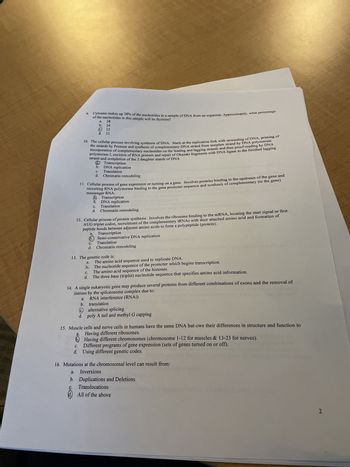
Human Anatomy & Physiology (11th Edition)
11th Edition
ISBN: 9780134580999
Author: Elaine N. Marieb, Katja N. Hoehn
Publisher: PEARSON
expand_more
expand_more
format_list_bulleted
Concept explainers
Topic Video
Question
Can you tell me the correct answers please can you tell me the answers using letters ABC or D

Transcribed Image Text:10. The cellular process involving synthesis of DNA. Starts at the replication fork with unwinding of DNA, priming of
the strands by Primase and synthesis of complementary DNA strand from template strand by DNA polymerase
incorporation of complementary nucleotides on the leading and lagging strands and then proof-reading by DNA
polymerase I, excision of RNA primers and repair of Okazaki fragments with DNA ligase to the finished lagging
strand and completion of the 2 daughter stands of DNA
Transcription
C.
d.
Cytosine makes up 38% of the nucleotides in a sample of DNA from an organism. Approximately, what percentage
of the nucleotides in this sample will be thymine?
a. 38
b. 24
Ⓒ12
d. 31
11. Cellular process of gene expression or turning on a gene. Involves proteins binding to the upstream of the gene and
recruiting RNA polymerase binding to the gene promoter sequence and synthesis of complementary (to the gene)
messenger RNA:
a.
b.
a.
a.
b. DNA replication
C.
d.
b.
C.
d.
(a)
b.
C.
d.
12. Cellular process of protein synthesis. Involves the ribosome binding to the mRNA, locating the start signal or first
AUG triplet codon, recruitment of the complementary tRNAs with their attached amino acid and formation of
peptide bonds between adjacent amino acids to form a polypeptide (protein).
Translation
Chromatin remodeling
Transcription
13. The genetic code is:
DNA replication
Translation
Chromatin remodeling
a.
Transcription
6. Semi-conservative DNA replication
Translation
C.
d. Chromatin remodeling
The amino acid sequence used to replicate DNA.
The nucleotide sequence of the promoter which begins transcription.
The amino acid sequence of the histones.
The three base (triplet) nucleotide sequence that specifies amino acid information.
14. A single eukaryotic gene may produce several proteins from different combinations of exons and the removal of
introns by the spliceosome complex due to:
RNA interference (RNAI)
translation
C.
alternative splicing
d. poly A tail and methyl G capping
15. Muscle cells and nerve cells in humans have the same DNA but owe their differences in structure and function to
a.
Having different ribosomes.
Having different chromosomes (chromosome 1-12 for muscles & 13-23 for nerves).
C.
Different programs of gene expression (sets of genes turned on or off).
d. Using different genetic codes.
16. Mutations at the chromosomal level can result from:
a.
Inversions
b. Duplications and Deletions
Translocations
All of the above
2
Expert Solution
This question has been solved!
Explore an expertly crafted, step-by-step solution for a thorough understanding of key concepts.
This is a popular solution
Trending nowThis is a popular solution!
Step by stepSolved in 3 steps

Knowledge Booster
Learn more about
Need a deep-dive on the concept behind this application? Look no further. Learn more about this topic, biology and related others by exploring similar questions and additional content below.Similar questions
- Hi Can you please help me answer this question , since I could not attach more then 2 image . Below I have attached the article first page . I hope that will help to find the article. Thank you !arrow_forwardi need the answer quicklyarrow_forwardCan you please answer the last four in complete sentence, not graded, thanksarrow_forward
- I need help with this one please don’t give me any copied answers from the internet! I need real help on this answer thank you.arrow_forwardPlease someone can help with some of my biology lab questions. Thank you so much if you can please answer in detailed.arrow_forwardPlease answer very soonarrow_forward
arrow_back_ios
SEE MORE QUESTIONS
arrow_forward_ios
Recommended textbooks for you
 Human Anatomy & Physiology (11th Edition)BiologyISBN:9780134580999Author:Elaine N. Marieb, Katja N. HoehnPublisher:PEARSON
Human Anatomy & Physiology (11th Edition)BiologyISBN:9780134580999Author:Elaine N. Marieb, Katja N. HoehnPublisher:PEARSON Biology 2eBiologyISBN:9781947172517Author:Matthew Douglas, Jung Choi, Mary Ann ClarkPublisher:OpenStax
Biology 2eBiologyISBN:9781947172517Author:Matthew Douglas, Jung Choi, Mary Ann ClarkPublisher:OpenStax Anatomy & PhysiologyBiologyISBN:9781259398629Author:McKinley, Michael P., O'loughlin, Valerie Dean, Bidle, Theresa StouterPublisher:Mcgraw Hill Education,
Anatomy & PhysiologyBiologyISBN:9781259398629Author:McKinley, Michael P., O'loughlin, Valerie Dean, Bidle, Theresa StouterPublisher:Mcgraw Hill Education, Molecular Biology of the Cell (Sixth Edition)BiologyISBN:9780815344322Author:Bruce Alberts, Alexander D. Johnson, Julian Lewis, David Morgan, Martin Raff, Keith Roberts, Peter WalterPublisher:W. W. Norton & Company
Molecular Biology of the Cell (Sixth Edition)BiologyISBN:9780815344322Author:Bruce Alberts, Alexander D. Johnson, Julian Lewis, David Morgan, Martin Raff, Keith Roberts, Peter WalterPublisher:W. W. Norton & Company Laboratory Manual For Human Anatomy & PhysiologyBiologyISBN:9781260159363Author:Martin, Terry R., Prentice-craver, CynthiaPublisher:McGraw-Hill Publishing Co.
Laboratory Manual For Human Anatomy & PhysiologyBiologyISBN:9781260159363Author:Martin, Terry R., Prentice-craver, CynthiaPublisher:McGraw-Hill Publishing Co. Inquiry Into Life (16th Edition)BiologyISBN:9781260231700Author:Sylvia S. Mader, Michael WindelspechtPublisher:McGraw Hill Education
Inquiry Into Life (16th Edition)BiologyISBN:9781260231700Author:Sylvia S. Mader, Michael WindelspechtPublisher:McGraw Hill Education

Human Anatomy & Physiology (11th Edition)
Biology
ISBN:9780134580999
Author:Elaine N. Marieb, Katja N. Hoehn
Publisher:PEARSON

Biology 2e
Biology
ISBN:9781947172517
Author:Matthew Douglas, Jung Choi, Mary Ann Clark
Publisher:OpenStax

Anatomy & Physiology
Biology
ISBN:9781259398629
Author:McKinley, Michael P., O'loughlin, Valerie Dean, Bidle, Theresa Stouter
Publisher:Mcgraw Hill Education,

Molecular Biology of the Cell (Sixth Edition)
Biology
ISBN:9780815344322
Author:Bruce Alberts, Alexander D. Johnson, Julian Lewis, David Morgan, Martin Raff, Keith Roberts, Peter Walter
Publisher:W. W. Norton & Company

Laboratory Manual For Human Anatomy & Physiology
Biology
ISBN:9781260159363
Author:Martin, Terry R., Prentice-craver, Cynthia
Publisher:McGraw-Hill Publishing Co.

Inquiry Into Life (16th Edition)
Biology
ISBN:9781260231700
Author:Sylvia S. Mader, Michael Windelspecht
Publisher:McGraw Hill Education